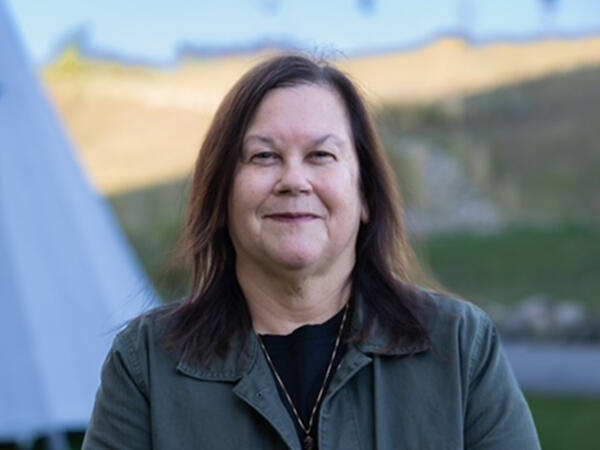Health care professionals working in the intensive care unit (ICU) are familiar with unpredictable and stressful situations, and complex patient loads. But a highly contagious viral pandemic and global shortages of critically important drugs created new challenges, even for seasoned ICU professionals.
Lisa Burry, assistant professor at the Leslie Dan Faculty of Pharmacy, is an experienced ICU pharmacist at Mount Sinai Hospital. Burry worked in the ICU during the SARS outbreak in 2003. Working during SARS gave her and her ICU colleagues a sense of what was to come early in the year as the severity of COVID-19 intensified.
“Some of the fear and anxiety that we dealt with through SARS probably helped us cope better with COVID-19. We had some insight as to the potential impact,” she says. “However, we were also fearful because we knew what was coming.”
That meant knowing the discomfort of wearing personal protective equipment all day long, the stress of being exposed to highly contagious patients for full shifts and demanding case loads. It also meant preparing for a surge of ICU patients and potential drug shortages.
As a member of the Society of Critical Care Medicine’s Fundamental Disaster Management Working Group and the American College of Chest Physician’s Task Force for Mass Critical Care and Disaster Management Steering Committee, Burry had important insight and access to resources, which she says was important in helping the ICU prepare for what was to come.
The hospital prepared for the height of the pandemic when it might exceed the ICU capacity, and it had created temporary ICUs in areas of the hospital that were not being used during the pandemic, such as post-op recovery rooms.
Burry’s research expertise – sedation and delirium in the ICU – put her in high demand to lead and support various research projects. Current practice for many conditions recommends that patients on ventilators receive pain medication to be calm and comfortable, but as alert and interactive as possible. However, this wasn’t possible with patients with COVID-19 who were put on ventilators, as they needed to be deeply sedated.
“Patients with COVID-19 in the ICU were ventilated for very long periods of time and had huge drug requirements for pain, agitation and delirium, just to make their ventilation safe,” she says.
“The amount of drug that was required per patient, per day was extraordinary.”
Hospitals across the province and the country were all experiencing the same scenario and trying to access the same sedatives, and supplies of the first-choice sedative began to run low. Now, on top of dealing with high numbers of patients and complex cases, pharmacists were facing shortages of essential drugs they needed.
“In the beginning, those of us in critical care were trying to solve these problems in isolation, and not recognizing that another site was dealing with the same thing,” says Burry. “That led to a group of us working together to deal with the issue on a provincial level and ultimately led to research to test new strategies to manage it.”
Challenges in patient care leads to new clinical trials
At a time when Burry’s clinical work was busier than ever, research opportunities were also rapidly growing. She worked closely with multi-disciplinary teams to develop research proposals to study potential solutions to the drug shortages they were facing in the ICU, two of which were successful. As co-investigator, Burry brings her valuable pharmacy perspective to research examining alternatives to traditionally used intravenous sedatives for patients on ventilators to ease pressure on the drug supply.
One trial, led by Drs. Angela Jerath and Brian Cuthbertson from Sunnybrook Health Sciences Centre and Dr. Claudio Martin and Marat Slessarev from London Health Sciences Centre, will compare inhaled gases typically used in the operating room to intravenous sedatives for COVID-19 patients on ventilators. Inhaled sedatives are not used outside of the operating rooms in North America, but are cheap, widely available and reduce lung inflammation and improve oxygen levels. But these sedatives have not typically been used for prolonged periods of time, such as in patients in the ICU.
“We know the way in which we sedate people, the drug we select, how we do it and how long we do it can all impact how long they spend with us and their overall recovery,” says Burry.
The trial is receiving more than $2 million from the Canadian Institutes for Health Research (CIHR) COVID-19 Rapid Response Competition, ranking the top research grant in the special competition.
“While the trial may be COVID-centric, it addresses issues we can apply far beyond this pandemic. This is valuable work because it has the ability to improve patient care, but also deal with drug shortages and issues without compromising patient care,” says Burry.
The second clinical trial, funded through a McMaster Medicine Associates Innovation Grant, is led by Dr. Alison Fox-Robichaud at Hamilton Health Sciences and Dr. James Downar at the Ottawa Hospital. It is examining whether adding the old beta-blocker propranolol to standard sedation regimens reduces the amount of primary sedative required, another approach to decrease the consumption of essential sedatives.
As Burry reflects on the challenges of the last several months, she is proud of the work that she has done serving both her patients and her profession through participating in the new research projects and the professional working groups.
“Access to drugs is an important part of disaster management, and I’m proud to have contributed to guidelines and protocols that have helped in this pandemic,” she says. “I’ve been given some good opportunities to be part of championing work that we’ve published about supply shortages.”
“Despite all the challenges of COVID, I’ve made new connections, built new research networks and learned to do things more quickly and efficiently. The research we are doing may improve treatment for COVID-19 and should lead to shorter ICU stays and improved outcomes. Some positive things have come out of the last few months.”
By Eileen Hoftyzer
More News
Image

Research team aims to co-design diabetes and dementia support programs that meet community needs
Network for Health Populations funding will support collaborative project to improve health outcomes for immigrant communities in Mississauga.
Read More
Image

Pharmaceutical industry resident finds growth in new challenges
Pharmaceutical Industry Residency Program Award recipient AnnaMaria Passas gained new skills through residency and research project to improve marketability in industry.
Read More
Image

Pharmacy alum sees change in acceptance of Indigenous cultures in health care
During Deborah Emery’s 40-year pharmacy career, she provided care in Sioux Lookout, Thunder Bay and Manitoulin Island.
Read More
